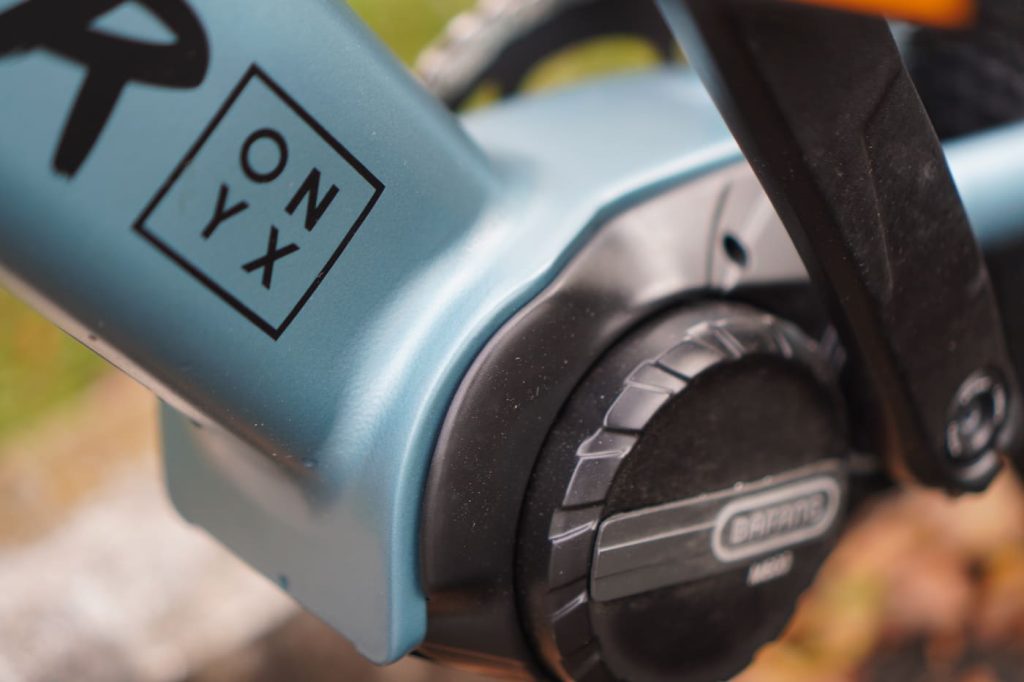[ad_1]

Electric dirt jumpers are a niche within a niche of the larger electric bike market. But while the ONYX LZR Pro e-bike doesn’t have much competition on either side of it as one of the models in its class, the bike still manages to stand out for its impressive build quality and ability to take it to the streets and the trails.
Now I’m not much of a jumper myself. I’ve seen the marketing images and videos from ONYX that show their team of pro riders flying across the sky on this e-bike and thought, “Well, there’s something I’ll never be able to do.”
And I was right. This isn’t going to be a review where I learn to defy gravity with the best of them. I’m not setting you up for a path-to-discovery type of story here, where the real dirt jumper was inside of me the whole time.
But what I did discover was just how much fun I can have on the trails and smaller jumps with a high-quality e-bike like the ONYX LZR Pro. I didn’t jump it off any loading docks or six-foot ramps, but I still had it nearly sideways on berms and slinging dirt in every direction. And if you’re a better rider than me, you could get some serious air time all day and night on this kind of bike without worrying that it won’t stand up to the abuse.
You can take a look at my own in-depth testing with my video review below. And if you want to dive even deeper, then keep on reading for the rest of my written review afterward.
ONYX LZR Pro video review
ONYX LZR Pro tech specs
- Motor: 900W Bafang M600 mid-drive motor
- Top speed: 28 mph (45 km/h)
- Range: 30-70 miles (51-112 km)
- Battery: 36V 14Ah (504Wh)
- Weight: 47 lb (21.3 kg)
- Frame: Aluminum alloy 6061
- Suspension: Front suspension fork with 100mm travel
- Brakes: Tektro hydraulic disc brakes
- Extras: Wood inlay LED dot meter for battery gauge and PAS level indicator, thru-axles, torque sensor, three color options (one for LZR Pro and two for LZR)
- Price: $1,999

Two bikes, two rides
First of all, you should know there are two different e-bikes in the LZR series. I tested the LZR Pro, which is the more powerful 900W version with the M600 Bafang mid-drive.
There’s also a slightly tamer 500W mid-drive version with a bit less torque (95 Nm vs. 120 Nm). They’re both quite similar otherwise, but you all know me — I’m going to opt for more power whenever possible.
Neither has a throttle, though, making these class 3 e-bikes in the purest form. That means that even though there’s good power here, you won’t be able to access it without some good old fashioned pedaling.

Build quality
The first thing you’ll notice about the LZR is the build quality. ONYX didn’t skimp on parts, and it starts right from the frame. They use something called Smooth Weld Additive Technology (SWAT), which somehow results in buttery smooth welds at the frame tube joints. I’ve seen beautiful frames before, and this one puts those other to shame.
Even down by the dropouts in the rear, where many nicely made frames tend to still have less-than-desirable weld finishing, the LZR Pro’s frame is immaculate. Whoever welded this thing took pride in their work and it shows.
The quality components continue around the bike. The bike uses BMX dirt jump hubs with true thru-axles instead of quick release skewers. The front is still a quick release to make it easy to pull out the wheel when necessary, but the thick thru-axles are designed to take the forces of repeated jumps and hard braking.

All the routing of cables and hoses is internal, including for the Tektro HD-M285 hydraulic disc brakes.
That front suspension fork offers 100mm of adjustable suspension with lockout for when you head back to the tarmac.
And there’s even a beautiful wooden inlay for the battery meter and pedal assist power level display. It reminds me of the wood on ONYX’s electric mopeds, and it helps create continuity in the company’s model lines, despite the very different designs and use cases.
Now as much as I love the way ONYX uses real wood in their products, the display on the ONYX LZR Pro is a bit simplistic because of that. You don’t get any speed readout with those five basics LEDs. Instead, you just get an approximate battery percentage with 20% increments and a 1-5 pedal assist level indicator. Does it work? Absolutely. Do I sometimes wish for more data? Also absolutely. I’m used to very detailed e-bike displays, and so moving to this simplistic display came with some adjustment period for me.

But I also get it. This is a dirt jumper. It’s a bike that will inevitably fly through the air and come crashing back down to earth. The fewer bits and pieces bolted onto it, the better. There’s less to break that way.
And that probably explains the lack of other parts like a derailleur, kickstand, LED lighting, or other added components that could become violently separated from the bike in a crash. You can add all of those (well, maybe except for the derailleur) if you wanted, but riders who use this bike for more extreme performance will likely accept that those parts are largely unnecessary. You’re not worried about being lit up for cars when you’re dropping in on a massive dirt ramp.
Since some riders will likely still use this bike for more commuter-oriented roles though, adding your own LED lights is probably a good idea.

How does it ride?
I tested the ONYX LZR Pro electric bike in a wide range of use cases. I took it commuting in bike lanes. I explored nature trails through the woods. I wound my way through singletrack switchbacks. And I even did a small amount of dirt jumping, at least as far as my primitive jumping skills would let me.
As a commuter bike, the fast and responsive pedal assist made it a great bike for taking the lane with cars or for slipping back into the bike lane when traffic got too heavy.
The bars are a bit wide for navigating some of the tighter areas in a city, especially if you frequently lane split like me and wiggle through cars in grid-locked traffic. But for anyone who mostly sticks to bike lanes, they’d be just fine.
The real fun starts when you head off-road. The powerful motor makes quick work of the trails. Most bikes can hold their own on relaxed nature trails, and the LZR Pro is no different. But it really shines when you get it on the more technical stuff.
The winding singletrack that I was riding was perfect for showing off how nimble the bike could be, and the up-and-down rollercoaster nature of the trails really accentuated the benefit of a powerful mid-drive for quickly climbing up inclines to get to the next downhill section. The responsive pedal assist gave me a nice boost, even when I only had time for a couple quick pedal rotations between switchbacks.



Since there is no hand throttle, I still felt like I was in the driver’s seat the entire time by providing my own pedaling. And I was still huffing and puffing a bit at the end of each trail, even though I had a powerful motor beneath me. I kept the pedal assist around level 2 out of 5 since the bendy trail made it hard to get going too fast. But on the straighter sections, I would bump the pedal assist up and really feel the wind in my face. And when back on the road, hitting pedal assist level 5 was a quick and easy way to get up to 28 mph (45 km/h) in a flash.
I’m sorry to say that I didn’t personally hit the big six-foot jumps that I’ve seen other people do with the ONYX LZR Pro. I wish I had those skills, but sadly I’ve always been more of an urban rider than an Evel Knievel. But a bike like this with such high-quality construction certainly gave me the confidence to get out of my comfort zone and get more air between my tires and the ground than I would normally feel comfortable with.
In case you’re wondering what it looks like when pro riders take to this thing, have a look at this.




What is this bike for?
So here’s the rub. Most people are probably more like me, in that you can have some fun off-roading but you’re more likely to be found on the streets and sidewalks than on a takeoff ramp.
In that case, the ONYX LZR Pro still works great as an urban bike. And we’ve seen plenty of stunt riding from ONYX’s pro rider team when they turn cities into bike parks and playgrounds. So we know it works just as well on the asphalt.
But for us average joes, there are still a few drawbacks. The lack of fenders or racks limit the bike’s utility for true commuter use. The nonremovable battery means you’ve got to bring the bike inside your apartment (or garage, if you’re lucky to have one of those) for charging. And the single-speed setup means you’re stuck with a single gear ratio (44T chainring and 14T rear sprocket). And all of that makes sense for a bike that is primarily designed to launch.
Even despite those drawbacks in the eyes of a more urban rider, the bike is so much fun as a dual-purpose runabout that I can look past those shortcomings. They exist not because the bike skimped in certain areas but because it’s specifically designed to be able to do more. And with the kind of build quality to make it rugged enough for that tougher riding that it’s designed for, it should last for years and years with normal city riding.
At its current sale price of just $1,999 (or $1,799 for the 500W version), the ONYX LZR Pro feels like a solid deal to me. That price is more than fair when you consider the quality parts and attention to detail in the construction of the bike.
This type of riding and this type of e-bike isn’t for everyone, that’s for sure. But for those looking for a bike that can handle this type of use, the ONYX LZR Pro is absolutely built to take it.

FTC: We use income earning auto affiliate links. More.
[ad_2]
Source link





